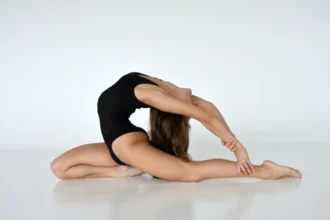In artistic gymnastics, a gymnast’s routine is evaluated on two primary components: the Difficulty Score (D-score) and the Execution Score (E-score). The D-score reflects the complexity and risk of the elements performed.
Each skill is assigned a value from A (0.1 points) to J (1.0 points), with higher values indicating more difficult skills. Vaults, in particular, have specific values ranging from 2.0 to 6.4 points, depending on their level of difficulty.
The highest-valued elements in a gymnast’s routine are those rated at the upper end of the scale, particularly H, I, and J elements. Mastering these high-difficulty skills is crucial for gymnasts aiming to compete at the highest levels, as they can make all the difference in tight competitions.
1. Vault
Vault is one of the most exciting and high-risk events in gymnastics. It involves a sprint toward the vaulting table, launching off to perform flips and twists in midair before landing. The value of a vault is determined by both its level of difficulty and the quality of execution.
Some of the highest-valued vaults include:
Yurchenko Double Pike (Value: 6.4)
This vault involves a round-off entry onto the springboard, followed by a back handspring onto the vaulting table. After pushing off, the gymnast performs two flips in a pike position before landing. It is one of the most difficult vaults for women and is valued at 6.4.
Amanar (Value: 6.3)
The Amanar is another high-difficulty vault requiring a handspring entry onto the vaulting table, followed by two and a half twists in the air. Its complexity and the control needed to execute it perfectly earn it a value of 6.3.
Cheng (Value: 6.0)
The Cheng vault includes a round-off entry, a handspring onto the vaulting table, and a double twist in the air. Known for its speed and power, it is valued at 6.0.
Kasamatsu Double (Value: 6.0)
The Kasamatsu Double begins with a round-off entry and a handspring onto the vaulting table. The gymnast then performs two flips in the air with a full twist. Its value of 6.0 reflects the precision and body awareness required for execution.
How Vault Difficulty is Determined
The difficulty of a vault is assessed based on:
- Vault Entry: Speed, technique, and control during the approach and takeoff.
- Flight Phase: The number of flips or twists, body position, and precision in the air.
- Landing: A clean, controlled landing without steps, hops, or falls.
2. Uneven Bars
The uneven bars event involves high-flying releases, intricate combinations, and fluid transitions. Elements on the bars are valued based on the gymnast’s ability to execute with speed, precision, and power.
Some of the highest-valued elements on bars include:
Biles (Value: 6.3)
Named after Simone Biles, this release move involves a back handspring to a double backflip in the air. The gymnast catches the bar after releasing it, which makes it one of the highest-valued release moves on bars.
Moulin (Value: 6.1)
The Moulin is a release move in which the gymnast performs a full turn in the air before catching the low bar. It is challenging because it requires both strength and impeccable timing.
Shushunova (Value: 6.0)
This release move involves a half-turn in the air before catching the bar again. The precision and control required during the release and re-grasp make it a high-difficulty move.
Stalder Full (Value: 5.9)
A full turn is performed on the low bar, where the gymnast swings into a fully extended position, and then performs a complete rotation around the bar.
How Uneven Bars Difficulty is Determined
Difficulty on the uneven bars is judged based on:
- Swing and Transfer: Maintaining fluid swings and smooth transitions between the bars.
- Release and Re-Grasp: The complexity of release moves increases the routine’s difficulty.
- Strength Elements: Moves like casts and press handstands require significant upper-body strength.
- Dismount: A clean dismount involving flips or twists adds to the difficulty.
3. Balance Beam
With only 4 inches of width to work with, the balance beam is one of the most challenging events in gymnastics. Gymnasts must execute acrobatic skills, jumps, leaps, and turns while maintaining perfect balance.
Highest-Valued Balance Beam Elements
Biles (Value: 6.4)
The Biles on beam involves a double-twisting double backflip. It is the most difficult acrobatic move on the beam and requires exceptional air awareness and body control for a safe landing.
Kochetkova (Value: 6.0)
This release move involves a back handspring, followed by a salto into a split leap. It requires strength and perfect body control to transition between the salto and the leap without losing balance.
Side Aerial (Value: 5.9)
The Side Aerial is a one-handed cartwheel on the beam, transitioning into a leap. It’s a high-difficulty skill due to the strength and balance needed to perform the non-traditional, asymmetrical movement.
Back Handspring Full Twist (Value: 5.8)
This involves a back handspring followed by a full twist in the air while balancing on the beam. It combines acrobatic motion with precision and control, increasing its difficulty.
How Balance Beam Difficulty is Determined
The difficulty of a beam routine is determined by:
- Acrobatic Elements: The number of flips, jumps, and aerial skills performed.
- Turns and Jumps: High-level jumps and twists increase the technical complexity.
- Transitions: Smooth transitions between acrobatic skills and dance elements.
- Dismount: A challenging dismount, such as a back handspring double tuck or twisting salto, increases the routine’s value.
4. Floor Exercise
Floor routines in gymnastics combine acrobatic tumbling passes, dance elements, and flexibility. The complexity of these routines is judged by the execution of elements as well as creativity and artistry.
Highest-Valued Floor Elements
Double-Double (Value: 6.4)
This tumbling pass involves two flips and two twists, making it one of the highest-value elements on floor.
Triple Twist (Value: 6.0)
A skill involving three full twists in the air before landing. It requires precise timing and control.
Full-In, Full-Out (Value: 6.3)
A tumbling pass involving a full twist followed by another full twist and flip. This move requires strong coordination and aerial awareness.
Double Layout (Value: 6.0)
This element involves two backflips performed in a straight body position. It requires both strength and technique to execute correctly.
How Floor Exercise Difficulty is Determined
The difficulty of a floor routine is judged based on:
- Tumbling Passes: More complex tumbling passes involving multiple flips or twists raise the difficulty.
- Dance and Choreography: Artistic elements such as leaps, jumps, and turns contribute to the routine’s technical value.
- Artistic Presentation: The creativity and fluidity of the choreography, synchronized with music, are important factors.
Conclusion
In gymnastics, the highest-valued elements are those that challenge a gymnast’s strength, precision, control, and creativity. From vaults with multiple twists to complex release moves on bars and acrobatic flips on beam and floor, these high-difficulty skills are key to achieving top scores. Mastering them not only elevates a gymnast’s routine but also increases their potential to compete at the highest levels of the sport.





